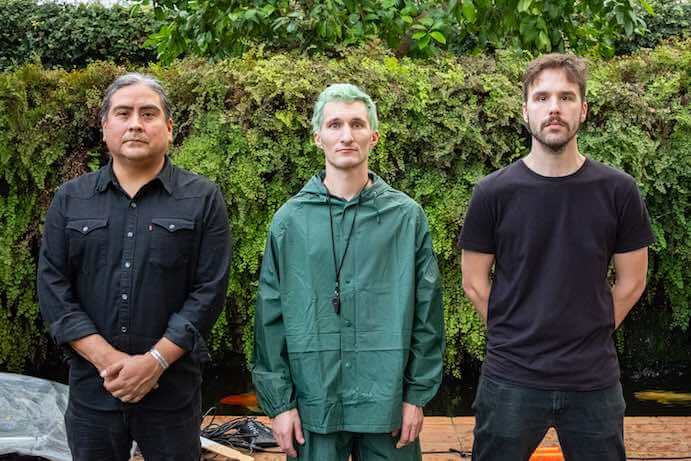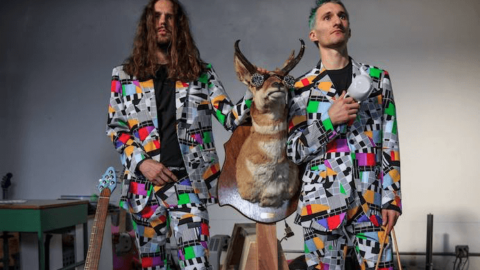The Living Earth Show (Travis Andrews and Andy Meyerson) is a San Francisco based percussion-guitar duo with a penchant for producing wildly different concerts. Their tenth anniversary season is jam-packed with works new and old that explore facets of space, identity, and community. Upcoming events include Raven Chacon’s Tremble Staves, a site-specific work on the water crisis facing the Western United States and Navajo Nation; Hyphen, an 80th-birthday celebration of groundbreaking Iranian composer Alireza Mashayekhi; and Danny Clay’s soul-searching spoken word opera Echoes, performed with Kronos Quartet and Youth Speaks. The Living Earth Show’s dedication to amplifying the radical voices of its collaborators is showcased this season, the culmination of a decade of creative work. We asked them five questions in advance of their season opening event on September 21st at Z Below in San Francisco.
Your tenth anniversary season brings together four brand new productions with a number of revived or ongoing projects from previous seasons. What are some of the highlights?
The four new productions on the season are some of the most extreme, challenging, and exciting we’ve ever been able to present. Each uses the foundation of contemporary experimental chamber music to create multimedia experiences that reflect and respond to the world in which these works were created.
Since so much of our work exists on the fringes of what can be considered a classical chamber music concert, we thought it was really important to start the season with a production presented in a traditional recital format. “Humble Servant,” an intimate recital program of five percussion solos presented on a proscenium stage, features works by composers who utilize ritual and repetition to find, and then blast well beyond, the limits of what a performer, the medium of percussion, and the human body are capable of. The counterpoint of works by Christopher Cerrone, Samuel Adams, and Adrian Knight–composers whose work demands exactitude specificity dictated by external musical electronic components–and those by Sarah Hennies and Amadeus Regucera–composers who create systems that are designed to fail and then use that human failure as an artistic tool–lays bare the vulnerability required in the creation and presentation of what we do. Building this piece has really left a mark on me as a musician. Literally, because I have to flog myself relentlessly in Amadeus’ piece, but also figuratively, as each of these five composers has really challenged what I thought was possible within the medium of solo percussion.
The next show is as far from a concert recital as we’ve ever presented. Performed outdoors at the ruins of Sutro Baths in collaboration with the Golden Gate National Parks Conservancy, Raven Chacon’s Tremble Staves is a ravishing, challenging, and ambitious site-specific, evening-length work. Tremble Staves uses water, the cliffs of Lands End, and the Pacific Ocean as dynamic percussion instruments. Almost four years in the making, the work connects narratives of the San Francisco Bay Area’s complicated relationship with water–usage, access, rights–to overlapping Navajo creation stories in which water figures prominently.

Raven explains the work better than I ever could: “On the surface, Tremble Staves is about water; the scarcity of it, especially in the desert where I am from, and of course its sacredness, we are water. But an artwork or music composition should not be what ultimately brings awareness to anyone at this point about the crisis we are facing. Perhaps we are doomed. The piece is the interactions and relationships that animals (people included) might have with each other, or with the land, or with nature, or with something else that we can’t comprehend, even at our most spiritual and vulnerable. The piece considers different moving and stationary bodies of water (tributaries, channels, sounds) as examples of these interactions; in how knowledge may be transferred, negotiated, shared, dispersed and even diluted. We wanted to bring this piece to the public, a site of water, of meditation. Of course anytime there is an opportunity to look at the ocean or the sky, one can attempt to peer toward infinity. We can be loud, and be seen from afar.”
In January, we’ll be premiering Hyphen, a program curated curated by Farnood HaghaniPour and serving as as a celebration of the 80th birthday of Alireza Mashayekhi, the legendary Iranian composer often credited as being the first composer of contemporary classical music in Iran. Mashayekhi’s influence resonates throughout the generations of diaspora of Iranian composers–represented in Hyphen by Aida Shirazi, Farnood HaghaniPour, Nima Rowshan, and the world premiere of Mashayekhi’s new work Labyrinth II.
The season concludes in July with Lyra, a new multimedia dance, musical, and visual art production, presented in collaboration with Post:Ballet. Lyra is the creation of acclaimed composer Samuel Adams (who was awarded the 2019 Guggenheim Foundation Fellowship to create this work, and who wrote The Living Earth Show’s first-ever commission in 2010), choreographer Vanessa Thiessen, director Robert Dekkers, Post:Ballet, and The Living Earth Show. Lyra uses the story of Orpheus and Eurydice as the foundation for an exploration of the human condition in the modern era, and represents Samuel Adams’s and The Living Earth Show’s most ambitious work to date.
Throughout the season, we will be recording and performing with COMMANDO, a collective of queer and trans artists coming together together to use the traditionally heteronormative vocabulary of heavy metal, rap, and poetry as a unified site to aggressively celebrate queerness and dismantle heteropatriarchy. The project was created in collaboration with a San Francisco-based collective of queer and trans artists including Lynne Breedlove, Juba Kalamka, Honey Mahogany, Drew Arriola-Sands, and Krylon Superstar, and it will be touring and recording throughout 2019-20.
The Living Earth Show’s aim is to be a megaphone and canvas for the artists who we believe to be making the most urgent, innovative, and important work today. We couldn’t be more proud to collaborate with dozens of visionary artists on our 10th season, to give these artists tools with which they can realize their most ambitious creative visions, and to premiere these works in San Francisco and beyond.

One thing that strikes me about your repertoire is the subject of physical space and connection, especially to San Francisco. Can you talk more about this?
Since The Living Earth Show is a presenting organization and a performing ensemble in equal measure, we strive to approach every concert with intentionality in terms of where and how it’s presented. When we commission a composer to create a new work for us, we ask them point blank: “To you, what’s the ideal manner in which this work you’re imagining would be presented and consumed?” The more one thinks about the physical space in which work is consumed, the more that physical space necessarily seeps into the work itself–and the stronger the bond between place, organization, and performers exists.
San Francisco is a beautiful, powerful, complicated, problematic, and wonderful place. The city has given us a home as an arts organization, and we feel that it’s our responsibility to facilitate the creation of work that can inform, interrogate, challenge, and help grow the community that has allowed us to exist.
Can you tell us about T.L.E.S.tival, the new initiative you are launching this year?
When the amazing folks at ODC approached us to collaborate on a residency, we wanted to work with them to develop a mini festival that would allow us to bring back to life two works we feel deserve the longest possible lives we can give them: Echoes, created in collaboration with Kronos Quartet, Danny Clay, and Youth Speaks, and Lordship & Bondage: The Birth of the Negro Superman, created with M. Lamar. One of the problems with time-based art is that it’s, well, temporary: once the show’s over, it’s over. Since the overwhelming majority of our work is specifically written for us, these productions often can’t exist unless we perform them. All too often, it feels like we’re rushing to get to the next thing; as soon as one program or production is over, the focus immediately turns to creating the next. This festival is an opportunity to revisit the works we’re most proud of, and create a two-night festival featuring some of our favorite artists in the world. We’re so lucky that M. Lamar, Kronos, Youth Speaks, and Danny Clay trusted us with their artistic visions, and it’ll be surreal to have a weekend in which we present both productions back to back.
What drives you to create work that focuses on identity, community, and cultural intersections?
Whether its creators acknowledge it or not, every piece of music ever written focuses on identity, community, and cultural intersections. When the San Francisco Symphony presents a Mahler program, it’s a fallacy to say that “identity, community, and cultural intersections” aren’t present. They absolutely are–it’s just that the “identity” is heteronormative cis male, the “community” is wealthy, and the “culture” is white folks. Don’t get me wrong: Mahler is one of my favorite composers, and hearing the San Francisco Symphony perform his work is truly amazing. But, in our field, it’s really easy to assume that “identity, community, and cultural intersections” are only present when the identities, communities, and cultures foregrounded are those that tend to be excluded (by design) from the classical music ecosystem.
There’s a lot of tremendously beautiful things about classical music as a field and as a tradition. It’s a vehicle for artistic expression unlike any other, and it is capable of creating profound and transcendent emotional experiences. That said, it has also done a pretty fantastic job of keeping people out on purpose. As an institution, classical music has done far more to reinforce the status quo (a status quo built on white supremacy, misogyny, and heteronormativity) than to dismantle it. Our job as an organization that facilitates the creation of new work is to make sure that the tools of tradition–some of the most powerful artistic tools ever created–get into the hands of the artists who deserve them.
If we can’t make it to California for theses shows, where can we find The Living Earth Show, online and what should we start with?
Our most recent album, Lordship & Bondage: The Birth of the Negro Superman, which we made with composer/countertenor/pianist/artistic provacateur M. Lamar, is on Bandcamp.
We haven’t publicized it much, but our first EP that we made with COMMANDO is a pretty jolly listen.
























